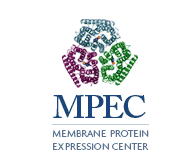Protein Purification
Detergents for extraction and for subsequent purification are separately optimized in a matrix, developed and tested. Column purifications include both Nickel, and cobalt columns, ion exchange and size exclusion columns. Characterization of the purified proteins at the MPEC will include mass determination, both equilibrium and velocity analytical ultracentrifugation to characterize homogeneity and homodispersity, and dynamic light scattering for oligomeric state and homogeneity.
Client laboratories from industry and academic centers may provide or nominate genes for expression. The MPEC provides for systematic application of each expression method to each new membrane protein or membrane protein class (implying several closely related proteins), followed by selection of the most productive of these (or other) systems for expression, and selection of that for expression and purification of client genes.
The MPEC gains by the rapid parallelized decision to focus onto one system, saving many decentralized efforts to express that protein. The MPEC methods offer the great advantage of allowing investigators to quickly decide which method is the best for their own expanded efforts.
Membrane Proteins — Current State
Crystallization of membrane proteins in a form that gives rise to high-resolution diffraction is one gold standard that establishes that a satisfactory extraction and purification of a particular membrane protein has been achieved. The total number of membrane protein structures worldwide (~70 in the year 2004) indicates a continuing improvement in these areas. In the Stroud laboratory, five membrane proteins have been crystallized and given rise to high resolution diffraction, and their structures solved at ~ 1.3Å - 2.5Å resolution. Placed in context of all the membrane proteins crystallized, or those crystallized in the Stroud laboratory, these indicate a general improvement in success rate that accompanies continuing improvements in the extraction and purification steps.
